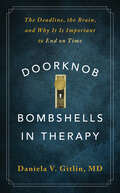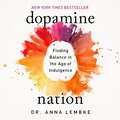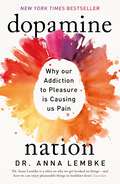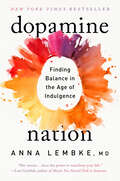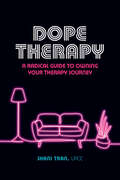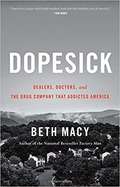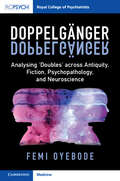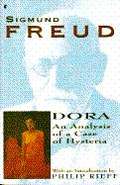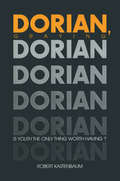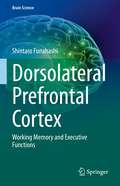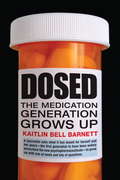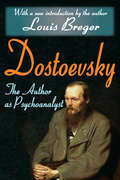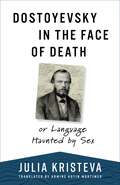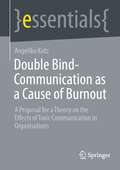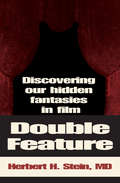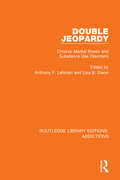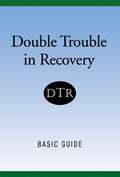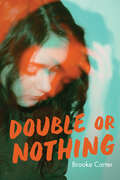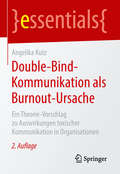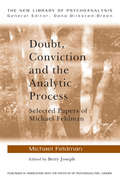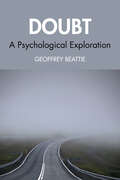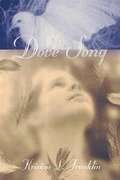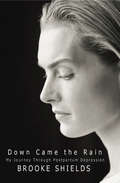- Table View
- List View
Doorknob Bombshells in Therapy: The Deadline, the Brain, and Why It Is Important to End on Time
by Daniela V. GitlinWhat should a therapist do when a patient reveals critical information at the end of a session? It’s a near-universal experience among mental health practitioners: a patient drops a bombshell—a critical disclosure that moves the treatment forward—on their way out, with a hand on the doorknob. This “doorknob moment” creates a stressful dilemma for clinicians, especially when the patient is distraught. Should the clinician end the session on time, or run over and be late for the next patient? Here, seasoned psychiatrist Daniela V. Gitlin provides clinicians with a clear, evidence-based answer. By conceptualizing the functional differences between patient and therapist in the treatment relationship as a metaphor for the functional differences between right and left cerebral hemispheres, Gitlin’s argument yields a comprehensive explanation for why doorknob moments occur, why they are necessary to prevent treatment stagnation, and why ending on time makes patients feel safer to deliver them.
Dopamine Nation: Finding Balance in the Age of Indulgence
by Dr Anna LembkeAll around us people are looking at their phones too much, eating too much, drinking too much. Our world is addicted to fleeting distracting pleasures that get us nowhere. Dr Anna Lembke provides a clear way back to a balanced life.This audiobook is about pleasure. It's also about pain. Most importantly, it's about how to find the delicate balance between the two, and why now more than ever finding balance is essential. We're living in a time of unprecedented access to high-reward, high-dopamine stimuli: drugs, food, news, gambling, shopping, gaming, texting, sexting, Facebooking, Instagramming, YouTubing, tweeting... The increased numbers, variety, and potency is staggering. The smartphone is the modern-day hypodermic needle, delivering digital dopamine 24/7 for a wired generation. As such we've all become vulnerable to compulsive overconsumption.In Dopamine Nation, Dr. Anna Lembke, psychiatrist and author, explores the exciting new scientific discoveries that explain why the relentless pursuit of pleasure leads to pain...and what to do about it. Condensing complex neuroscience into easy-to-understand metaphors, Lembke illustrates how finding contentment and connectedness means keeping dopamine in check. The lived experiences of her patients are the gripping fabric of her narrative. Their riveting stories of suffering and redemption give us all hope for managing our consumption and transforming our lives. In essence, Dopamine Nation shows that the secret to finding balance is combining the science of desire with the wisdom of recovery.'Dr Anna Lembke is a whiz on why we get hooked on things - and how we can enjoy pleasurable things in healthier doses.' - The Guardian(P) 2021 Penguin Random House Audio
Dopamine Nation: Finding Balance in the Age of Indulgence
by Dr Anna Lembke'Her stories have the power to transform your life' Lori Gottlieb, bestselling author of Maybe You Should Talk to Someone 'Radically changes the way we think about mental illness, pleasure, pain, reward and stress' Daniel Levitin, bestselling author of The Organized MindTHE NEW YORK TIMES AND SUNDAY TIMES BESTSELLER We are a wired generation. In these fast-paced times we are constantly bombarded by high-reward, high-dopamine stimuli. From texting to social media, food to drugs, gambling to shopping, we have become addicted to fleeting and distracting pleasures that are making us sick.In Dopamine Nation, psychiatrist and bestselling author Dr Anna Lembke reveals why our relentless pursuit of pleasure leads to pain and what we can do about it. Bringing together cutting-edge neuroscience with the gripping real life experiences from her clinical practice, Lembke explores how contentment and connectedness are essential tools in keeping dopamine in check. This is an essential book for anyone wanting to find a balance for a happier life.
Dopamine Nation: Finding Balance in the Age of Indulgence
by Dr. Anna LembkeINSTANT NEW YORK TIMES and LOS ANGELES TIMES BESTSELLER&“Brilliant . . . riveting, scary, cogent, and cleverly argued.&”—Beth Macy, author of Dopesick,as heard on Fresh AirThis book is about pleasure. It&’s also about pain. Most important, it&’s about how to find the delicate balance between the two, and why now more than ever finding balance is essential. We&’re living in a time of unprecedented access to high-reward, high-dopamine stimuli: drugs, food, news, gambling, shopping, gaming, texting, sexting, Facebooking, Instagramming, YouTubing, tweeting . . . The increased numbers, variety, and potency is staggering. The smartphone is the modern-day hypodermic needle, delivering digital dopamine 24/7 for a wired generation. As such we&’ve all become vulnerable to compulsive overconsumption. In Dopamine Nation, Dr. Anna Lembke, psychiatrist and author, explores the exciting new scientific discoveries that explain why the relentless pursuit of pleasure leads to pain . . . and what to do about it. Condensing complex neuroscience into easy-to-understand metaphors, Lembke illustrates how finding contentment and connectedness means keeping dopamine in check. The lived experiences of her patients are the gripping fabric of her narrative. Their riveting stories of suffering and redemption give us all hope for managing our consumption and transforming our lives. In essence, Dopamine Nation shows that the secret to finding balance is combining the science of desire with the wisdom of recovery.
Dope Therapy: A Radical Guide to Owning Your Therapy Journey
by Shani TranSeeking help is hard. Dope Therapy makes it easier.For many people, there is fear and stigma associated with entering the therapy room. Maybe you&’ve been told that going to therapy means something is wrong with you. Maybe you don&’t know what to expect. Even if you recognize the benefits of seeking help, it can feel scary and unknown to take that first step. If you&’ve thought about therapy but don&’t know where to start, or if you&’ve tried therapy in the past but it hasn&’t helped, Dope Therapy is for you. With humor and compassion, author and therapist Shani Tran validates the anxiety that can arise around seeking counseling and offers guidance for navigating the uncomfortable conversations that can come up in therapy. She is with you each step of the way, from finding the right therapist to determining when you&’ve reached the end of your therapy journey. Get answers to your questions, including: • Why isn&’t therapy working? • What if I don&’t want to take medication? • How do I deal with all these feelings? • What will happen if I tell my therapist that I&’m having suicidal thoughts? • How do I break up with my therapist?"What a breath of fresh air! This book lays out everything you need to know about therapy and how to navigate it - especially if you are BIPOC, queer, or young. Finally, a fun, accessible book that can guide people to the help they need." —Ryan Schwartz, founder, Mental Health Match
Dopesick: Dealers, Doctors, and the Drug Company that Addicted America
by Beth Macy<P>The only book to fully chart the devastating opioid crisis in America: "a harrowing, deeply compassionate dispatch from the heart of a national emergency" (New York Times) from a bestselling author and journalist who has lived through itIn this masterful work, Beth Macy takes us into the epicenter of America's twenty-plus year struggle with opioid addiction. <P>From distressed small communities in Central Appalachia to wealthy suburbs; from disparate cities to once-idyllic farm towns; it's a heartbreaking trajectory that illustrates how this national crisis has persisted for so long and become so firmly entrenched. <P>Beginning with a single dealer who lands in a small Virginia town and sets about turning high school football stars into heroin overdose statistics, Macy endeavors to answer a grieving mother's question-why her only son died-and comes away with a harrowing story of greed and need. <P>From the introduction of OxyContin in 1996, Macy parses how America embraced a medical culture where overtreatment with painkillers became the norm. In some of the same distressed communities featured in her bestselling book Factory Man, the unemployed use painkillers both to numb the pain of joblessness and pay their bills, while privileged teens trade pills in cul-de-sacs, and even high school standouts fall prey to prostitution, jail, and death. <P>Through unsparing, yet deeply human portraits of the families and first responders struggling to ameliorate this epidemic, each facet of the crisis comes into focus. <P>In these politically fragmented times, Beth Macy shows, astonishingly, that the only thing that unites Americans across geographic and class lines is opioid drug abuse. But in a country unable to provide basic healthcare for all, Macy still finds reason to hope-and signs of the spirit and tenacity necessary in those facing addiction to build a better future for themselves and their families. <P><b>A New York Times Bestseller</b>
Doppelgänger: Analysing ‘Doubles' across Antiquity, Fiction, Psychopathology, and Neuroscience
by Femi OyebodeThe concept of doppelgänger, or 'double' – a conceived exact but sometimes invisible replica of a living person – has fascinated and intrigued people for centuries. This notion has a long history and is a widespread belief among cultural groups around the world. Doppelgängers have influenced literature and cinema, with writers such as Fyodor Dostoyevsky and Robert Louis Stevenson, and directors like Alfred Hitchcock exploring the phenomenon to great effect. This book brings together the literary and cinematic with empirical scientific literature to raise fundamental questions about the nature of the self and the human mind. It aims to establish the experience of the self and unravel the brain processes that determine bodily representation and the errors that make possible the experience of the doppelgänger phenomenon. This book will appeal to psychiatrists, neurologists, and neuroscientists, as well as interested general readers.
Dora: An Analysis of a Case of Hysteria
by Sigmund FreudThe case history involves a complicated set of liaisons of Dora, her father, her mother, Mr. K., Mrs. K., and the governess.
Dorian Graying: Is Youth the Only Thing Worth Having? (Society and Aging Series)
by Robert KastenbaumIn his latest and perhaps most adventuresome book, Robert Kastenbaum offers a fresh view of the quest for perpetual youth. The focus is on the "pretty monster" that Oscar Wilde created a century ago in "The Picture of Dorian Gray". We see Dorian first within the frame of his own times, responding to the pressures of modernization by attempting to escape the natural progression of time. Next we enter Dorian, the Opera, a re-imagining of his quest in the postmodern world of interactive computers. Finally, we observe Dorian's obsession and plight in our own graying society. This insightful analysis of the dangers inherent in becoming "terminally young" also provides a set of propositions worth consideration by gerontologists, educators, philosophers, media mavens, and policy-makers.
Dorsolateral Prefrontal Cortex: Working Memory and Executive Functions (Brain Science)
by Shintaro FunahashiThe prefrontal cortex is known to play important roles for performing a variety of higher cognitive functions. Among regions of the prefrontal cortex, the dorsolateral prefrontal cortex plays the most important roles for these functions. This book focuses on functions of the dorsolateral prefrontal cortex, summarizes research results obtained mainly by non-human primate studies, and describes neural mechanisms of executive functions that the dorsolateral prefrontal cortex participates. First, to understand the feature of the dorsolateral prefrontal cortex and how its function has been understood, anatomical and functional features of the dorsolateral prefrontal cortex and historical overview of prefrontal functions are described. To understand functions of the prefrontal cortex and neural mechanisms of executive functions, working memory is an important concept and sustained activation during the memory period of working memory tasks is known as a neural mechanism of working memory. Therefore, this book describes features of sustained memory-related activity based on neurophysiological results obtained in the prefrontal cortex and how memory-related activity contributes to executive functions including control of attention, inhibitory control, task management, and planning. And further, this book describes how the dorsolateral prefrontal cortex contributes to neural mechanisms for sensory and motor processing, memory control in multi-task performance, decision-making, metacognition, and top-down control. Thus, this book provides important information regarding neural mechanisms of dorsolateral prefrontal functions to neuroscientists and helps to plan further investigation to understand prefrontal functions in primates and human subjects.
Dosed: The Medication Generation Grows Up
by Kaitlin Bell BarnettOver the last two decades, we have seen a dramatic spike in the number of young people taking psychiatric medication--but, despite a heated debate on the issue, we haven't heard directly from the "medicated kids" themselves. In Dosed, Kaitlin Bell Barnett, who was diagnosed with depression as a teenager, weaves together stories from members of this medication generation, exploring their experiences at home, in school, and with the psychiatric profession. For many, taking meds has proved more complicated than merely popping a pill, as they try to parse their changing emotions, symptoms, side effects, and diagnoses without conclusive scientific research on how the drugs affect developing brains and bodies. While negotiating schoolwork, relationships, and the workplace, they also struggle to find the right drug, deal with breakdowns, decide whether they still need treatment at all--and, ultimately, make sense of their long-term relationship to psychotropic drugs. The results of what one psychopharmacologist describes as a "giant, uncontrolled experiment" are just starting to trickle in. Barnett shows that a lack of ready answers and guidance has often proven extremely difficult for these young people as they transition from childhood to adolescence and now to adulthood. With its in-depth accounts of individual experiences combined with sociological and scientific context, Dosed provides a much-needed road map for patients, friends, parents, and those in the helping professions trying to navigate the complicated terrain of growing up on meds.
Dostoevsky: The Author as Psychoanalyst
by George SantayanaAndre Gide once said that Feodor Dostoevsky "lost himself in the characters of his books, and, for this reason, it is in them that he can be found again." In "Dostoevsky: The Author as Psychoanalyst", Louis Breger approaches Dostoevsky psychoanalytically, not as a "patient" to be analyzed, but as a fellow psychoanalyst, someone whose life and fiction are intertwined in the process of literary self-exploration.Raskolnikov's dream of the suffering horse in "Crime and Punishment" has become one of the best known in all literature, its rich imagery expressing meaning on many levels. Using this as a starting point, Breger goes on to offer a detailed analysis of the novel, situating it at the pivotal point in Dostoevsky's life between the death of his first wife and his second marriage. Using insights from his psychological training, Breger also explores other works by Dostoevsky, among them his early novel, "The Double", which Breger relates to the nervous breakdown that Dostoevsky suffered in his twenties, as well as "Notes from Underground", "The Possessed", "The Idiot", "The Brothers Karamazov", and so forth. Additionally, details from Dostoevsky's own life - his compulsive gambling, his epilepsy, his philosophical, political, religious, and mystical beliefs, and the interpretations of them found in existing biographies - are analyzed in detail.
Dostoyevsky in the Face of Death: or Language Haunted by Sex (European Perspectives: A Series in Social Thought and Cultural Criticism)
by Julia KristevaJulia Kristeva has been both attracted and repelled by Dostoyevsky since her youth. In this extraordinary book, by turns poetic and intensely personal, she brings her unique critical sensibility to bear on the tormented and visionary Russian author.Kristeva ranges widely across Dostoyevsky’s novels and his journalism, plunging deep into the great works—and many of the smaller ones—to investigate her fascination with the Russian author. What emerges is a luminous vision of the writer’s achievements, seen in a wholly new way through Kristeva’s distinctive perspective on language. With her keen psychoanalytical eye, she offers brilliant insights into the passionate heroines of the great novels. Focusing on Dostoyevsky’s polyphonic writing, Kristeva also demonstrates the importance of Orthodox Christianity throughout his body of work, analyzing the complex ways his carnivalesque theology informs his fiction and commentary.An original and profound interpretation of one of the nineteenth century’s greatest writers, this book’s insights are also relevant to the twentieth and twenty-first centuries—up to our unsettled present, to which Kristeva’s humane reading of the suffering Russian author brings understanding and even solace.
Double Bind-Communication as a Cause of Burnout: A Proposal for a Theory on the Effects of Toxic Communication in Organisations (essentials)
by Angelika KutzIn this Springer essential, Angelika Kutz examines how paradoxical double bind communication affects employees and organizations. The aim is to make transparent the self-esteem-destroying machinery and disease-promoting effect of the toxic communication pattern double bind. From the research findings, the author derives the following questions: Are Burnout and Organizational Burnout in truth Double Bind-induced work attachment and work relationship disorders? Does Double Bind and the relationship disorder based on it fuel the increasing loss of values and thus the self-destruction of the global Double Bind society?
Double Exposure: How Social Psychology Fell in Love with the Movies
by Kathryn MillardDouble Exposure examines the role of film in shaping social psychology’s landmark postwar experiments. We are told that most of us will inflict electric shocks on a fellow citizen when ordered to do so. Act as a brutal prison guard when we put on a uniform. Walk on by when we see a stranger in need. But there is more to the story. Documentaries that investigators claimed as evidence were central to capturing the public imagination. Did they provide an alibi for twentieth century humanity? Examining the dramaturgy, staging and filming of these experiments, including Milgram's Obedience Experiments, the Stanford Prison Experiment and many more, Double Exposure recovers a new set of narratives.
Double Feature: Discovering Our Hidden Fantasies in Film
by Herbert H. Steina) What recent smash hit movie secretly depicted fear of the female breast? b) Name some recent films that were preoccupied with castration anxiety? c) Would you be surprised to know that reliving our childhood Oedipal fixations helps us to better understand adult-themed films? You'll find the answers to these and many similarly intriguing questions in DOUBLE FEATURE: DISCOVERING OUR HIDDEN FANTASIES IN FILM by Herbert Stein, M.D. Dr. Stein, a highly-respected Freudian psychiatrist and passionate moviegoer, literally puts our favorite films on the couch and shares his confidential findings with us. In a book that could become a cult classic, he lays bare the truth about unconscious and subconscious themes running through popular culture with fresh, jolting, and often moving insights into some of the most popular films ever made, including JURASSIC PARK, FIELD OF DREAMS, FORRST GUMP, THE SIXTH SENSE, and THE USUAL SUSPECTS. However perceptive we may think ourselves, this book reveals how we unconsciously respond to deeply-embedded archetypal themes in movies and enables us to re-experience films we love in a completely fresh way. Indeed, DOUBLE FEATURE makes our favorite films even more resonant and enables us to articulate even more deeply what it is we love about them.
Double Jeopardy: Chronic Mental Illness and Substance Use Disorders (Routledge Library Editions: Addictions #2)
by Anthony F. Lehman and Lisa B. DixonOriginally published in 1995, this title provides a practical examination of the problems of substance abuse and abuse among persons with chronic mental disorders. Epidemiologic, diagnostic, and treatment issues are examined, as well as the problems of special populations and systems issues. This book will be of interest to practising clinicians in both the mental health and substance abuse treatment sectors.
Double Trouble In Recovery: Basic Guide
by Howard VogelSince 1989, clients with severe co-occurring addiction and mental health disorders have found experience, strength, and hope through the Twelve Step group Double Trouble in Recovery (DTR).Since 1989, clients with severe co-occurring addiction and mental health disorders have found experience, strength, and hope through the Twelve Step group Double Trouble in Recovery (DTR). This is the equivalent to the Alcoholics Anonymous Book for those dealing with severe mental illness and addiction. Priced economically for distribution to group members.
Double or Nothing (Orca Soundings)
by Brooke CarterKey Selling Points A math genius with a gambling problem is in over her head. This book explores the devastating effects of addiction. The main character has an identical twin who gets sucked into her unsavoury lifestyle. The author has written several other hi-lo books, including The Unbroken Hearts Club , Learning Seventeen and Another Miserable Love Song in the Orca Soundings series. New, enhanced features (dyslexia-friendly font, cream paper, larger trim size) to increase reading accessibility for dyslexic and other striving readers.
Double-Bind-Kommunikation als Burnout-Ursache: Ein Theorie-Vorschlag zu Auswirkungen toxischer Kommunikation in Organisationen (essentials)
by Angelika KutzIn diesem essential untersucht Angelika Kutz, wie sich paradoxe Double-Bind-Kommunikation auf Mitarbeiter und Organisationen auswirkt. Ziel ist es, die Selbstwert-Vernichtungsmaschinerie und krankheitsfördernde Wirkung des toxischen Kommunikationsmusters Double Bind transparent zu machen. Aus den Untersuchungsergebnissen leitet die Autorin folgende Fragen ab: Sind Burnout und Organizational Burnout in Wahrheit eine Double-Bind-induzierte Arbeitsbindungs- und Arbeitsbeziehungsstörung? Heizt Double Bind und die darauf basierende Beziehungsstörung den zunehmenden Werteverlust und damit die Selbstzerstörung der globalen Double-Bind-Gesellschaft an?
Doubt, Conviction and the Analytic Process: Selected Papers of Michael Feldman (The New Library of Psychoanalysis)
by Michael FeldmanIn this profound and subtle study, a practising psychoanalyst explores the dynamics of the interaction between the patient and the analyst. Michael Feldman draws the reader into experiencing how the clinical interaction unfolds within a session. In doing so, he develops some of the implications of the important pioneering work of such analysts as Klein, Rosenfeld and Joseph, showing in fine detail some of the ways in which the patient feels driven to communicate to the analyst, not only in order to be understood by him, but also in order to affect him. The author's detailed descriptions of the clinical process allow the reader to follow the actual process that enables the patient to get into contact with thoughts and feelings of which he or she was previously unconscious or only vaguely aware. Feldman makes the reader aware of the constant dynamic interaction between the patient and the analyst, each affecting the other. He shows how the analyst has to find a balance between doubt, uncertainty and confusion in himself and through this process may arrive at an understanding of what is happening, and by formulating this understanding the analyst can make a significant contribution to the process of psychic change. This collection of essays not only throws light on fascinating questions of technique, but also reflects on elements that are fundamental to psychoanalytic work. It is essential reading for practising psychoanalysts and those in training, as well as anyone with a general interest in the psychoanalytic relationship between the client and the therapist in the consulting room.
Doubt: A Psychological Exploration
by Geoffrey BeattieBlending the latest academic research with case studies of famous figures, this highly insightful book presents ‘doubt’ as a central concept for psychology. It is a concept which has been oddly neglected in the past, despite its ubiquitous nature and far-reaching influence. Exploring everything from self-doubt and impostor syndrome to the weaponisation of doubt with respect to climate change and the marketing of cigarettes, bestselling author Geoffrey Beattie navigates readers through the various ways doubt can start and develop, changing the individual in the process. Written in Beattie’s distinctive and engaging style, Doubt takes the reader into the lives of transformational thinkers, artists, scientists and writers to explore how and why doubt was crucial in their lives and how the likes of Kafka, Jung, Picasso and Turing succumbed to doubt or learned to control it. Beattie argues that doubt is central to the self; it can be either a safeguarding mechanism or a distraction, rational or irrational, systematic or random, healthy or pathological, productive or non-productive. The book helps readers to recognise how doubt may have been operating in their own lives and to identify how and when it has been used against us – for example, to prevent climate action – and at what personal and societal cost. Presenting a compelling case for why doubt cannot be ignored, this book is of major interest to academics from a wide range of disciplines, including social and cognitive psychology, clinical and counselling psychology, sport psychology, sociology, business studies, politics, art and literature, as well as the general public, who may well see something of themselves in its pages.
Doubts and Certainties in the Practice of Psychotherapy
by Josephine KleinThis book is a collection of occasional papers on the practice of psychotherapy for pre-qualification students and for more experienced professionals, focusing on the development of some psychoanalytic theories into their social and historical context.
Dove Song
by Kristine L. FranklinWhen eleven-year-old Bobbie Lynn's father is reported missing in action in Vietnam, she and her thirteen-year-old brother must learn to cope with their own despair, as well as their mother's breakdown.
Down Came the Rain: My Journey Through Postpartum Depression
by Brooke ShieldsIn this compelling memoir, Brooke Shields talks candidly about her experience with postpartum depression after the birth of her daughter, and provides millions of women with an inspiring example of recovery. When Brooke Shields welcomed her newborn daughter, Rowan Francis, into the world, something unexpected followed--a crippling depression. Now, for the first time ever, in Down Came the Rain, Brooke talks about the trials, tribulations, and finally the triumphs that occurred before, during, and after the birth of her daughter.
